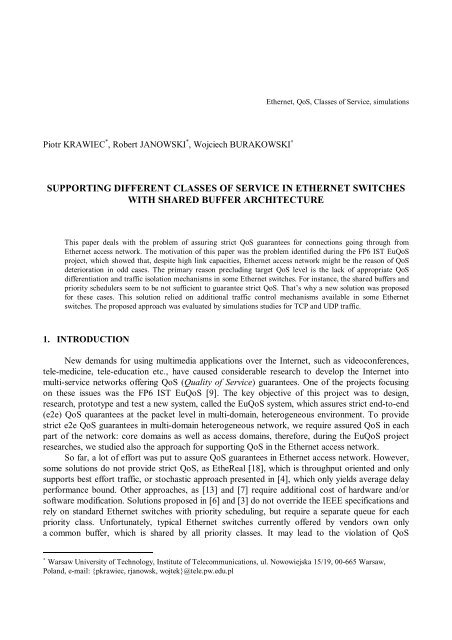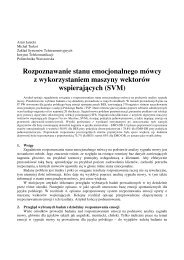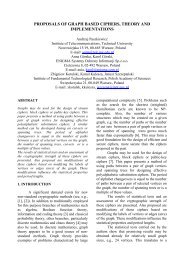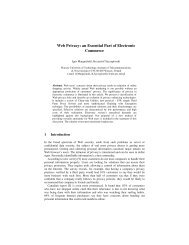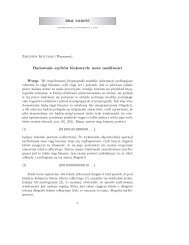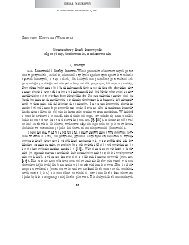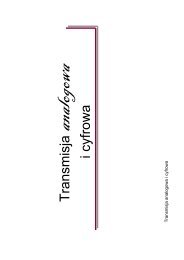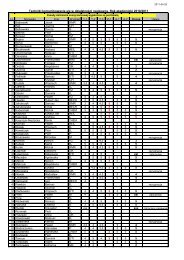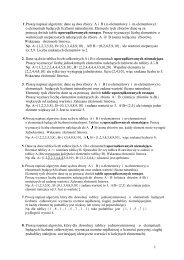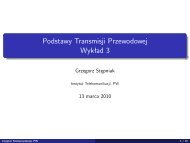supporting different classes of service in ethernet switches with ...
supporting different classes of service in ethernet switches with ...
supporting different classes of service in ethernet switches with ...
Create successful ePaper yourself
Turn your PDF publications into a flip-book with our unique Google optimized e-Paper software.
Ethernet, QoS, Classes <strong>of</strong> Service, simulations<br />
Piotr KRAWIEC * , Robert JANOWSKI * , Wojciech BURAKOWSKI ∗<br />
SUPPORTING DIFFERENT CLASSES OF SERVICE IN ETHERNET SWITCHES<br />
WITH SHARED BUFFER ARCHITECTURE<br />
This paper deals <strong>with</strong> the problem <strong>of</strong> assur<strong>in</strong>g strict QoS guarantees for connections go<strong>in</strong>g through from<br />
Ethernet access network. The motivation <strong>of</strong> this paper was the problem identified dur<strong>in</strong>g the FP6 IST EuQoS<br />
project, which showed that, despite high l<strong>in</strong>k capacities, Ethernet access network might be the reason <strong>of</strong> QoS<br />
deterioration <strong>in</strong> odd cases. The primary reason preclud<strong>in</strong>g target QoS level is the lack <strong>of</strong> appropriate QoS<br />
<strong>different</strong>iation and traffic isolation mechanisms <strong>in</strong> some Ethernet <strong>switches</strong>. For <strong>in</strong>stance, the shared buffers and<br />
priority schedulers seem to be not sufficient to guarantee strict QoS. That’s why a new solution was proposed<br />
for these cases. This solution relied on additional traffic control mechanisms available <strong>in</strong> some Ethernet<br />
<strong>switches</strong>. The proposed approach was evaluated by simulations studies for TCP and UDP traffic.<br />
1. INTRODUCTION<br />
New demands for us<strong>in</strong>g multimedia applications over the Internet, such as videoconferences,<br />
tele-medic<strong>in</strong>e, tele-education etc., have caused considerable research to develop the Internet <strong>in</strong>to<br />
multi-<strong>service</strong> networks <strong>of</strong>fer<strong>in</strong>g QoS (Quality <strong>of</strong> Service) guarantees. One <strong>of</strong> the projects focus<strong>in</strong>g<br />
on these issues was the FP6 IST EuQoS [9]. The key objective <strong>of</strong> this project was to design,<br />
research, prototype and test a new system, called the EuQoS system, which assures strict end-to-end<br />
(e2e) QoS quarantees at the packet level <strong>in</strong> multi-doma<strong>in</strong>, heterogeneous environment. To provide<br />
strict e2e QoS guarantees <strong>in</strong> multi-doma<strong>in</strong> heterogeneous network, we require assured QoS <strong>in</strong> each<br />
part <strong>of</strong> the network: core doma<strong>in</strong>s as well as access doma<strong>in</strong>s, therefore, dur<strong>in</strong>g the EuQoS project<br />
researches, we studied also the approach for <strong>support<strong>in</strong>g</strong> QoS <strong>in</strong> the Ethernet access network.<br />
So far, a lot <strong>of</strong> effort was put to assure QoS guarantees <strong>in</strong> Ethernet access network. However,<br />
some solutions do not provide strict QoS, as EtheReal [18], which is throughput oriented and only<br />
supports best effort traffic, or stochastic approach presented <strong>in</strong> [4], which only yields average delay<br />
performance bound. Other approaches, as [13] and [7] require additional cost <strong>of</strong> hardware and/or<br />
s<strong>of</strong>tware modification. Solutions proposed <strong>in</strong> [6] and [3] do not override the IEEE specifications and<br />
rely on standard Ethernet <strong>switches</strong> <strong>with</strong> priority schedul<strong>in</strong>g, but require a separate queue for each<br />
priority class. Unfortunately, typical Ethernet <strong>switches</strong> currently <strong>of</strong>fered by vendors own only<br />
a common buffer, which is shared by all priority <strong>classes</strong>. It may lead to the violation <strong>of</strong> QoS<br />
∗ Warsaw University <strong>of</strong> Technology, Institute <strong>of</strong> Telecommunications, ul. Nowowiejska 15/19, 00-665 Warsaw,<br />
Poland, e-mail: {pkrawiec, rjanowsk, wojtek}@tele.pw.edu.pl
guarantees <strong>of</strong> high priority traffic <strong>in</strong> case when the whole Ethernet switch buffer is occupied by low<br />
priority traffic.<br />
In this paper we present an approach to assure strict QoS guarantees <strong>in</strong> the Ethernet access<br />
network. We assume the use <strong>of</strong> currently accessible Ethernet equipment, <strong>with</strong> shared buffers, priority<br />
scheduler and traffic control mechanism similar to WRED (Weighted Random Early Detection). No<br />
further modification <strong>of</strong> switch s<strong>of</strong>tware or hardware is necessary.<br />
The rest <strong>of</strong> the paper is organized as follows: Section 2 describes the ma<strong>in</strong> problem treated <strong>in</strong><br />
this paper, i.e. the assurance <strong>of</strong> target QoS level <strong>in</strong> Ethernet access network <strong>with</strong> <strong>switches</strong>, which<br />
conta<strong>in</strong> shared buffers. In Section 3 the proposed solution is presented while <strong>in</strong> Section 4 it is<br />
evaluated by a series <strong>of</strong> simulations. Section 5 summarizes the paper.<br />
2. STATEMENT OF THE PROBLEM<br />
The approach for assur<strong>in</strong>g QoS <strong>in</strong> multi-doma<strong>in</strong> networks, which has been applied <strong>in</strong> the<br />
EuQoS project, bases on the implementation <strong>of</strong> end-to-end Classes <strong>of</strong> Service (e2e CoSs) [5]<br />
dedicated to handle packets generated by respective type <strong>of</strong> application, e.g. VoIP (Voice over IP).<br />
Roughly speak<strong>in</strong>g, the e2e CoS corresponds to the network capabilities for transferr<strong>in</strong>g the packets<br />
belong<strong>in</strong>g to selected connections <strong>with</strong> assumed QoS guarantees. These QoS guarantees are<br />
expressed by the follow<strong>in</strong>g metrics (as def<strong>in</strong>ed <strong>in</strong> [10]): (1) IP packet loss ratio IPLR, (2) IP packet<br />
transfer delay IPTD and (3) IP packet delay variation IPDV.<br />
With<strong>in</strong> the IST EuQoS project, five e2e CoSs have been def<strong>in</strong>ed: Telephony, RT Interactive,<br />
MM Stream<strong>in</strong>g, High Throughput Data (HTD) and Standard (STD) CoSs, accord<strong>in</strong>g to <strong>different</strong><br />
types <strong>of</strong> traffic pr<strong>of</strong>iles generated by the <strong>different</strong> applications studied <strong>in</strong> EuQoS. The maximum<br />
values <strong>of</strong> QoS metrics (i.e. IPLR, IPTD and IPDV) for each e2e CoS one can f<strong>in</strong>d <strong>in</strong> [11].<br />
To implement these e2e CoSs, adequate CAC (Connection Admission Control) algorithms<br />
were designed (to limit the QoS traffic) and appropriate QoS mechanisms like schedulers, shapers,<br />
policers etc., available <strong>in</strong> network elements were used. Only <strong>in</strong> the case <strong>of</strong> Standard CoS there is<br />
neither CAC function performed nor the QoS parameters are guaranteed s<strong>in</strong>ce this CoS is <strong>in</strong>tended<br />
to provide similar <strong>service</strong> as Best Effort network, i.e. <strong>with</strong>out guarantees <strong>in</strong> the QoS parameters.<br />
The implementation <strong>of</strong> e2e CoSs runs <strong>in</strong>to <strong>different</strong> obstacles when consider<strong>in</strong>g each <strong>of</strong><br />
possible access network technologies i.e. WiFi, UMTS, xDSL or Ethernet. In our paper we focus on<br />
the problem <strong>of</strong> Ethernet access network. In this technology the primary mechanism to <strong>different</strong>iate<br />
traffic is Priority Scheduler, practically available <strong>in</strong> almost every <strong>switches</strong>. The 802.1p specification<br />
(which is a part <strong>of</strong> IEEE 802.1D [8]) def<strong>in</strong>es 8 priority <strong>classes</strong>, and EuQoS project proposed the<br />
mapp<strong>in</strong>g between them and end-to-end EuQoS CoSs as presented <strong>in</strong> table 1.<br />
Table 1. Mapp<strong>in</strong>g between end-to-end EuQoS CoSs and Ethernet priority <strong>classes</strong>.<br />
e2e EuQoS CoS<br />
Telephony,<br />
MM Stream<strong>in</strong>g,<br />
RT Interactive High Throughput Data<br />
Standard<br />
Ethernet priority class Voice Controlled Load Best Effort<br />
802.1p priority value 6 (high) 4 0 (low)<br />
The mapp<strong>in</strong>g shown <strong>in</strong> table 1 implies that the traffic from STD CoS is served <strong>with</strong> the lowest<br />
priority <strong>in</strong> comparison <strong>with</strong> other e2e EuQoS CoSs. Unfortunately, typical Ethernet <strong>switches</strong> do not<br />
support per class buffer but only a common one, which is shared by all CoSs <strong>in</strong>clud<strong>in</strong>g STD CoS.<br />
Although this buffer is quite large – usually thousands <strong>of</strong> packets, the fact it is shared poses the ma<strong>in</strong><br />
problem [15]. S<strong>in</strong>ce CAC function, by def<strong>in</strong>ition, does not control the amount <strong>of</strong> traffic submitted to
STD CoS, it is possible that this traffic overloads the network and fully occupies the Ethernet buffer.<br />
This situation may deteriorate IPLR metric <strong>of</strong> other CoSs, s<strong>in</strong>ce the arriv<strong>in</strong>g packets from other<br />
CoSs will be dropped due to the lack <strong>of</strong> room <strong>in</strong> shared buffer space. The mechanism <strong>of</strong> shared<br />
buffer comb<strong>in</strong>ed <strong>with</strong> the priority schedul<strong>in</strong>g has been symbolically shown <strong>in</strong> fig. 1 by us<strong>in</strong>g model <strong>of</strong><br />
Drop Tail queue at the entrance to the Ethernet buffer but Priority Scheduler at the exit.<br />
It is worth mention<strong>in</strong>g that IPTD and IPDV metrics, <strong>in</strong> spite <strong>of</strong> the shared buffer, will never be<br />
<strong>in</strong>fluenced s<strong>in</strong>ce once a packet enters <strong>in</strong>to the shared buffer, it is scheduled to the transmission<br />
accord<strong>in</strong>g to the priority rules and, hence the traffic from STD CoS cannot delay the packets from<br />
other CoSs [11]. Thus, the problem <strong>of</strong> assur<strong>in</strong>g appropriate performance <strong>of</strong> e2e EuQoS CoSs <strong>in</strong><br />
Ethernet network is ma<strong>in</strong>ly the problem <strong>of</strong> controll<strong>in</strong>g traffic from STD CoS and prevent<strong>in</strong>g it from<br />
occupy<strong>in</strong>g too much buffer space avoid<strong>in</strong>g, <strong>in</strong> this way, the packet losses due to shared buffer space.<br />
Ethernet switch<br />
High priority<br />
Shared<br />
buffer – B e<br />
PQ<br />
Low priority<br />
Fig. 1. Model <strong>of</strong> shared buffer <strong>in</strong> Ethernet <strong>switches</strong>.<br />
3. THE PROPOSED SOLUTION<br />
The ma<strong>in</strong> idea to alleviate the problem outl<strong>in</strong>ed <strong>in</strong> section 2 relies on controll<strong>in</strong>g the buffer<br />
space occupied by each CoS. In this way, we assure the isolation between the <strong>different</strong> CoSs. First <strong>of</strong><br />
all, we dist<strong>in</strong>guish between the CoSs, for which we guarantee some level <strong>of</strong> QoS (we refer to them<br />
as QoS CoSs) and the STD CoS, for which we do not guarantee any level <strong>of</strong> QoS. Such<br />
a classification is caused because we may apply <strong>different</strong> methods for controll<strong>in</strong>g the occupancy <strong>of</strong><br />
the buffer space for QoS CoSs and for STD CoS. In the first case, as any <strong>of</strong> the connections<br />
belong<strong>in</strong>g to the QoS CoSs must pass the CAC function, the amount <strong>of</strong> the occupied buffer space<br />
can be controlled by appropriate resource provision<strong>in</strong>g and configuration <strong>of</strong> the CAC function.<br />
However, <strong>in</strong> the case <strong>of</strong> STD CoS the approach described above is not possible because the<br />
connections belong<strong>in</strong>g to this CoS are not controlled by CAC function. To control the volume <strong>of</strong> this<br />
traffic and the shared buffer occupancy due to it, we propose a solution designed to <strong>switches</strong> that<br />
support traffic control mechanism similar to WRED. The desired isolation <strong>of</strong> CoSs might be<br />
achieved when the size <strong>of</strong> the common Ethernet buffer B e is able to accommodate the whole buffer<br />
space required by the QoS CoSs (B QoS ) and by the STD CoS (B STD ). It means that the Ethernet<br />
switch buffer size should meet the follow<strong>in</strong>g condition: B e > B QoS + B STD . More precisely, for each<br />
QoS CoS (i.e. for each Ethernet priority class associated <strong>with</strong> it) we can dedicate the buffer size B i-j<br />
(j=1,..,7) tak<strong>in</strong>g <strong>in</strong>to account the adequate QoS requirements. For example, for Telephony CoS we<br />
design rather short buffers to guarantee low IPDV values. This buffer size B i-j , together <strong>with</strong><br />
dedicated capacity C i-j is later used by RA (Resource Allocator), the control module responsible for<br />
perform<strong>in</strong>g CAC algorithm and resource reservations, to calculate the CAC limit for the given<br />
output port i for particular CoS j. S<strong>in</strong>ce all orig<strong>in</strong>at<strong>in</strong>g and term<strong>in</strong>at<strong>in</strong>g connections which use these<br />
CoSs must pass the CAC function performed <strong>in</strong> the RA module, we can control the volume <strong>of</strong> the<br />
traffic <strong>of</strong>fered to each QoS CoS <strong>with</strong><strong>in</strong> each output port (see fig. 2).
Resource Allocator<br />
AC decision<br />
Term<strong>in</strong>al<br />
Shared buffer<br />
B e<br />
Term<strong>in</strong>al<br />
Input port<br />
Ethernet switch<br />
B i-j C i-j<br />
Output port<br />
Fig. 2. Resource Allocator (RA) module controls the volume <strong>of</strong> the traffic by perform<strong>in</strong>g CAC algorithm for dedicated<br />
resources: buffer size B i-j and capacity C i-j .<br />
The CAC algorithm used by RA module <strong>in</strong> Ethernet access network depends on the CoS it is<br />
used for. In general, the requirements for IPLR and mean IPTD determ<strong>in</strong>e the maximum admissible<br />
load ρmax that can be accepted <strong>in</strong> given QoS CoS. The maximum admissible load ρmax,IPTD that<br />
satisfies the requirement for mean IPTD is determ<strong>in</strong>ed based on the Pollaczek-Kh<strong>in</strong>tch<strong>in</strong> formula:<br />
2( IPTD<br />
− T<br />
−<br />
)<br />
L<br />
ρ<br />
max, IPTD<br />
prop C<br />
=<br />
L<br />
2IPTD<br />
− 2T<br />
prop<br />
−<br />
C<br />
(1)<br />
where T prop denotes the propagation delay (which also contributes to mean IPTD), L denotes the<br />
packet length (<strong>in</strong> bits) and C denotes the fraction <strong>of</strong> l<strong>in</strong>k capacity dedicated to the given QoS CoS.<br />
On the other hand, the requirement for target IPLR determ<strong>in</strong>es another value <strong>of</strong> the maximum<br />
admissible load, namely ρmax,IPLR. The lower <strong>of</strong> these two values is f<strong>in</strong>ally considered as the maximum<br />
admissible load ρmax to the given QoS CoS:<br />
ρ<br />
max<br />
= m<strong>in</strong>[ ρ<br />
max, IPTD<br />
; ρ<br />
max, IPLR<br />
]<br />
(2)<br />
For Telephony CoS, the value <strong>of</strong> ρmax,IPLR is calculated based on the dedicated buffer size B i-6 ,<br />
and the target IPLR value accord<strong>in</strong>g to the algorithm described <strong>in</strong> [17]. The value <strong>of</strong> B i-6 is<br />
determ<strong>in</strong>ed from the provisioned capacity C i-6 and the requirement on the IPDV value, which is<br />
def<strong>in</strong>ed as an upper bound <strong>of</strong> the maximum packet queue<strong>in</strong>g delay.<br />
In the case <strong>of</strong> STD CoS the approach described above is not possible because the connections<br />
belong<strong>in</strong>g to this CoS are not controlled by CAC function. To control the volume <strong>of</strong> this traffic and<br />
the shared buffer occupancy due to it we propose a solution which is designed for <strong>switches</strong> that<br />
support traffic control mechanism similar to WRED. For example, such mechanism is available <strong>in</strong><br />
Super Stack 4 5500 Ethernet switch which was a part <strong>of</strong> EuQoS test bed. As recognized <strong>in</strong> the<br />
relevant technical documentation [2], this WRED mechanism lets us set the queue threshold Q th,i-j<br />
and the dropp<strong>in</strong>g probability P drop,i-j for each output port i and each Ethernet priority level<br />
j <strong>in</strong>dependently. Furthermore, it works <strong>in</strong> the follow<strong>in</strong>g way: when a new packet arrives, the<br />
correspond<strong>in</strong>g output port i and associated Ethernet priority level j are determ<strong>in</strong>ed, then the size <strong>of</strong><br />
the adequate queue Q i-j is compared <strong>with</strong> the earlier configured threshold Q th,i-j . If the queue size is<br />
below than Q th,i-j the packet is queued <strong>in</strong> the common buffer, otherwise it is dropped <strong>with</strong> probability<br />
P drop,i-j . In comparison <strong>with</strong> WRED mechanism known from routers, where the two queue size<br />
thresholds are specified and the dropp<strong>in</strong>g decisions are worked out on the basis <strong>of</strong> the avaraged<br />
queue size, it is a k<strong>in</strong>d <strong>of</strong> simpliefied version <strong>with</strong> only one queue size threshold and the packet drop<br />
desicions based on the <strong>in</strong>stantenous queue size.
The ma<strong>in</strong> idea <strong>of</strong> the proposed solution is that by sett<strong>in</strong>g the appropriate threshold Q th,i-0 for the<br />
queue Q i-0 associated <strong>with</strong> STD CoS (j=0) on the output port i and the related dropp<strong>in</strong>g probability<br />
P drop,i-0 , we are able to drop the excessive traffic and, <strong>in</strong> this way, we tend to keep the buffer<br />
occupancy (due to STD CoS on this output port) below the value Q th,i-0 . This is suited for STD CoS<br />
s<strong>in</strong>ce, on one hand, it has no guarantees about IPLR, IPTD nor IPDV values and, on the other hand,<br />
it carries ma<strong>in</strong>ly TCP controlled traffic <strong>with</strong> possibly greedy behavior tend<strong>in</strong>g to grab all the available<br />
capacity and the buffer space B e . Unfortunately, Super Stack 4 5500 lets for sett<strong>in</strong>g the P drop value<br />
only <strong>in</strong> the range [1]. It means that <strong>in</strong> the case when the thresholds are exceeded, we can<br />
never drop the whole traffic <strong>in</strong>com<strong>in</strong>g to the Ethernet switch but, at the most, only the 92% <strong>of</strong> it.<br />
However, as most <strong>of</strong> the STD CoS traffic uses TCP transport protocol we assume that this method<br />
is sufficient for bound<strong>in</strong>g the maximum buffer occupancy.<br />
When the above approach is applied to all N output ports <strong>of</strong> the Ethernet switch, the total<br />
result<strong>in</strong>g occupancy B STD <strong>of</strong> the shared buffer due to STD CoS traffic should stay below the value:<br />
N<br />
B STD<br />
Border Router (BR) are configurable. S<strong>in</strong>ce we want to perform the tests <strong>in</strong> conditions when ES is a<br />
bottleneck we set the capacities C 1 and C 2 equal. To create the congestion conditions <strong>with</strong> a<br />
m<strong>in</strong>imum set <strong>of</strong> term<strong>in</strong>als generat<strong>in</strong>g traffic (which is important when perform<strong>in</strong>g trials <strong>in</strong> test bed)<br />
the <strong>in</strong>put l<strong>in</strong>ks are configured <strong>with</strong> capacity 100Mbps i.e. 10 times faster than l<strong>in</strong>ks C 1 and C 2 .<br />
We have evaluated the possibility <strong>of</strong> <strong>support<strong>in</strong>g</strong> e2e CoSs <strong>in</strong> a set <strong>of</strong> scenarios, where the<br />
traffic from only one e2e QoS CoS (Telephony, RT-Interactive, etc.) together <strong>with</strong> STD CoS traffic<br />
was present at the same time. In each test we measured relevant QoS parameters <strong>of</strong> a s<strong>in</strong>gle traffic<br />
stream constitut<strong>in</strong>g so called Foreground Traffic (FT). However, for these measurements to be<br />
adequate we provoked the worst traffic conditions <strong>in</strong> the network that are allowed by CAC<br />
algorithm. It means that we loaded a tested e2e CoS to ρmax value. This additional type <strong>of</strong> traffic<br />
creat<strong>in</strong>g CAC limit condition, we refer to as Background Traffic (BT). The FT and BT were<br />
appropriately modelled depend<strong>in</strong>g on the type <strong>of</strong> tested e2e QoS CoS. Due to space limitation <strong>in</strong> this<br />
paper we present only the simulation results obta<strong>in</strong>ed for the case <strong>of</strong> Telephony and STD CoS.<br />
In the performed tests we <strong>different</strong>iated between the case where the STD CoS traffic used<br />
TCP (section 4.1) or UDP (section 4.2). This <strong>different</strong>iation is important because the applied<br />
transport protocol impacts traffic characteristics mostly due to the presence or lack <strong>of</strong> closed-loop<br />
congestion control, respectively.<br />
The details <strong>of</strong> simulated traffic scenario are as follows. There are only two types <strong>of</strong> traffic: one<br />
represent<strong>in</strong>g traffic from Telephony CoS, for which we must guarantee target QoS level and the<br />
other one, which represents traffic from STD CoS. The Telephony CoS FT and BT traffic comes<br />
from the term<strong>in</strong>al connected to Ethernet port #2 and STD CoS traffic from term<strong>in</strong>al connected to<br />
port #1. The whole traffic is dest<strong>in</strong>ed to BR across ES and ER. The propagation delay T prop between<br />
ER and BR is set to 0 ms reflect<strong>in</strong>g the low distances between particular elements <strong>of</strong> the Ethernet<br />
access network. The capacity dedicated to Telephony CoS on C 1 l<strong>in</strong>k is C 28-6 =2Mbps. Packets<br />
belong<strong>in</strong>g to this class are 200B long and packets belong<strong>in</strong>g to STD CoS are 1500B long. FT and<br />
BT <strong>of</strong> Telephony CoS are modelled as CBR stream (parameters relevant for G.711 codec) and<br />
Poisson stream, respectively. The parameters <strong>of</strong> the WRED mechanism are the follow<strong>in</strong>g: threshold<br />
is set to 85 pkts (and this value <strong>in</strong>dicates maximum buffer space assumed for STD CoS), dropp<strong>in</strong>g<br />
probability is set to 0.92. The Ethernet shared buffer value is B e =1000 pkts.<br />
The simulation studies were performed us<strong>in</strong>g ns-2 platform [14]. The results were obta<strong>in</strong>ed by<br />
repeat<strong>in</strong>g the simulation tests 12 times and calculat<strong>in</strong>g the mean values <strong>with</strong> the correspond<strong>in</strong>g 95%<br />
confidence <strong>in</strong>tervals. However, the confidence <strong>in</strong>tervals were not given <strong>in</strong> cases they are negligible.<br />
Each simulation test lasted for 1000 seconds.<br />
4.1 TCP STREAMS INTO STD COS<br />
In this test the STD CoS traffic consists <strong>of</strong> N=10 TCP greedy connections. The nom<strong>in</strong>al values<br />
<strong>of</strong> QoS parameters that we assumed for the Telephony CoS <strong>in</strong> Ethernet access network are<br />
summarized <strong>in</strong> table 2 (we refer to them as to “designed values”). These values were used to<br />
determ<strong>in</strong>e the traffic load that we admitted <strong>in</strong>to Telephony CoS.<br />
For this test, the measured IPLR, mean IPTD and IPDV are below target designed values (see<br />
table 2). Measured IPLR equals 0 s<strong>in</strong>ce the buffer space dedicated to Telephony CoS (B 28-6 =10<br />
packets) was much less than the whole Ethernet switch buffer size and the buffer occupancy due to<br />
STD CoS was well controlled. In fact when STD CoS traffic is TCP controlled the maximum STD<br />
CoS queue size Q max (determ<strong>in</strong>ed <strong>with</strong> probability 10 -3 ) deviates only a little from the WRED<br />
threshold which was set to 85 packets (see table 3). Thanks to TCP mechanism, after the STD CoS<br />
queue reaches WRED threshold and the new arriv<strong>in</strong>g packet is dropped, the TCP source slows down
its send<strong>in</strong>g rate lett<strong>in</strong>g the STD CoS queue size to decrease. The measured IPDV value was also<br />
below the designed value because Telephony CoS traffic was served <strong>with</strong> priority on the l<strong>in</strong>k <strong>with</strong><br />
physical capacity 10Mbps and this value is much higher than the assumed provisioned capacity C 28-<br />
6=2Mbps. Also the measured mean IPTD was below the designed value but the reason was that for<br />
this simulation ρmax=0.714 was determ<strong>in</strong>ed from IPLR as a more constra<strong>in</strong><strong>in</strong>g factor (see eq. 2).<br />
Table 2. Simulation results <strong>of</strong> QoS parameters for Telephony CoS.<br />
QoS parameter Designed value Measured value<br />
IPLR 10 -3 0<br />
IPTD [ms] 2.5 2.0<br />
IPDV [ms] 8 1.3±0.1<br />
Table 3. Simulation results <strong>of</strong> the queue size <strong>in</strong> ES.<br />
Tested e2e CoS<br />
Measured queue size <strong>in</strong> ES [pkts]<br />
Parameter name Q Mean Q max : Prob{Q>Q max }Q max }
4.2.2 RESULTS WITH IMPROVED THRESHOLD TUNING<br />
The simulation studies performed for Ethernet access network showed that controll<strong>in</strong>g shared<br />
buffer occupancy due to STD CoS traffic by means <strong>of</strong> WRED mechanism is not a trivial task. S<strong>in</strong>ce<br />
the control <strong>of</strong> the occupied buffer space is crucial to provide separation between CoSs and <strong>in</strong> this<br />
way, to assure target values <strong>of</strong> QoS parameters, we must precisely control it. It means that only<br />
when STD CoS traffic is TCP controlled, we can assume that the queue size <strong>of</strong> STD CoS is well<br />
limited to the WRED threshold. In the case when this traffic is UDP we cannot assume that the STD<br />
CoS queue size is around desired WRED threshold s<strong>in</strong>ce the simulations proved it is much above it.<br />
For this case, we need to control the queue size more precisely e.g. by sett<strong>in</strong>g lower value <strong>of</strong> WRED<br />
threshold to start dropp<strong>in</strong>g packets earlier. The question aris<strong>in</strong>g is the top value <strong>of</strong> WRED threshold<br />
<strong>in</strong> order not to exceed the target maximum queue size. The answer comes from the analysis <strong>of</strong> the<br />
phenomena, which is responsible for the excessively grow<strong>in</strong>g queue.<br />
S/N<br />
N<br />
CBR traffic<br />
dropp<strong>in</strong>g<br />
WRED<br />
k<br />
Poisson traffic<br />
Fig. 4 Characteristics <strong>of</strong> the arriv<strong>in</strong>g packet stream after pass<strong>in</strong>g WRED mechanism<br />
S<strong>in</strong>ce <strong>in</strong> the considered case, the capacity C 3 is 10 times higher than capacity C 1 and the STD<br />
CoS traffic is assumed to be CBR <strong>with</strong> rate equal to C 3 (see fig. 3), then, dur<strong>in</strong>g the <strong>service</strong> time <strong>of</strong><br />
each STD CoS packet on the l<strong>in</strong>k C 1 , other 10 packets <strong>of</strong> STD CoS arrive to the output port #28.<br />
When the queue size <strong>of</strong> STD CoS packets gathered on port #28 exceeds the WRED threshold (here<br />
85 packets), the WRED mechanism starts dropp<strong>in</strong>g the arriv<strong>in</strong>g STD CoS packets. However, it<br />
drops each <strong>of</strong> them <strong>with</strong> a probability 0.92. On average the rate <strong>of</strong> STD CoS traffic, which passes<br />
through the WRED is only 8 Mbps (i.e. 8% <strong>of</strong> <strong>in</strong>com<strong>in</strong>g traffic) which guarantees that the system is<br />
stable s<strong>in</strong>ce the total rate <strong>of</strong>fered to the output port #28 equals 9.428 Mbps (8 Mbps due to STD<br />
CoS traffic and ρmax×C 28,6 =0.714×2Mbps=1.428 Mbps due to Telephony CoS traffic) and stays<br />
below the <strong>service</strong> rate C 1 (10 Mbps). However, because <strong>of</strong> the probabilistic nature <strong>of</strong> WRED packet<br />
dropp<strong>in</strong>g, it might happen that for some period <strong>of</strong> time more packets than the foreseen average will<br />
pass through the WRED. These packets will contribute to the extensive growth <strong>of</strong> the queue beyond<br />
the WRED threshold. In order to understand how this queue grows it is necessary to characterize the<br />
stream <strong>of</strong> packets that have passed WRED. The fig. 4 illustrates the dependencies between the<br />
packet <strong>service</strong> time S on the l<strong>in</strong>k C 1 , the orig<strong>in</strong>al CBR packet stream (N=10 new packets dur<strong>in</strong>g the<br />
<strong>service</strong> time S) and the stream <strong>of</strong> packets that have passed WRED (k packets out <strong>of</strong> any N arriv<strong>in</strong>g).<br />
S<strong>in</strong>ce consecutive packets are dropped by WRED <strong>in</strong>dependently, the probability distribution <strong>of</strong><br />
the number <strong>of</strong> packets that are not dropped (k out <strong>of</strong> N) is b<strong>in</strong>omial:<br />
⎟⎠⎞<br />
=⎜⎝⎛<br />
S<br />
Pr ob{<br />
k}<br />
N<br />
k<br />
k<br />
p (1 − p)<br />
( N −k)<br />
,<br />
where k = 0,1,..., N and N = 10<br />
(4)
<strong>with</strong> parameter p=0.08 (probability that WRED does not drop the packet).<br />
For our purpose, this distribution can be replaced by Poisson distribution (<strong>with</strong> mean equal to<br />
N×p) as the latter one has greater variability and thus, we can consider the results obta<strong>in</strong>ed <strong>with</strong> the<br />
Poisson distribution as an upper bound. After characteriz<strong>in</strong>g the packet stream, which contributes to<br />
the STD CoS queue, we proceed <strong>with</strong> the analysis. The start<strong>in</strong>g po<strong>in</strong>t is the follow<strong>in</strong>g model <strong>with</strong><br />
two CoSs: Telephony and STD and the traffic loads ρ1 and ρ2, respectively (see fig. 5a).<br />
Telephony<br />
CoS<br />
STD CoS<br />
Poisson ρ1<br />
Poisson ρ2<br />
High priority<br />
1<br />
Low priority<br />
ρ1=0.1428<br />
ρ2=0.8<br />
*<br />
Poisson ρ2<br />
ρ2<br />
* =0.933<br />
STD CoS 1<br />
a) two queue system b) adequate s<strong>in</strong>gle queue system<br />
Fig. 5 The approach for analys<strong>in</strong>g low priority (STD CoS) queue size<br />
From the po<strong>in</strong>t <strong>of</strong> view <strong>of</strong> STD CoS traffic, we may replace the orig<strong>in</strong>al model (fig. 5a) by<br />
a s<strong>in</strong>gle queue system <strong>with</strong> Poisson stream as an <strong>in</strong>put and appropriately recalculated ρ2 * , which<br />
considers the impact <strong>of</strong> the high priority traffic (Telephony CoS) on the low priority one (STD CoS)<br />
[12] (see fig. 5b). The load ρ2 * is determ<strong>in</strong>ed bas<strong>in</strong>g on the follow<strong>in</strong>g equation:<br />
* ρ2<br />
ρ2<br />
= (5)<br />
1−<br />
ρ<br />
1<br />
Next, we can approximate the STD CoS queue size probability distribution us<strong>in</strong>g the formula<br />
proposed <strong>in</strong> [16]:<br />
Pr ob{<br />
Queue > x}<br />
≈ e<br />
From (6), we can determ<strong>in</strong>e the target value <strong>of</strong> the queue size (X) exceeded only <strong>with</strong> some<br />
small probability P 0 :<br />
*<br />
The equation (7) gives us the <strong>in</strong>formation how the target value <strong>of</strong> the queue size X depends on<br />
the chosen probability P 0 and the system load ρ2 * . If we want to assure that the STD CoS queue size<br />
<strong>in</strong> Ethernet switch will exceed the value L only <strong>with</strong> probability P 0 , we have to set such a threshold T<br />
that added to additional queue growth X, <strong>of</strong>fers a value not greater than L, as described <strong>in</strong> (8):<br />
⇒<br />
The equation (8) provides the guidel<strong>in</strong>e to set the value <strong>of</strong> WRED threshold T when want the<br />
STD CoS queue size to be below L <strong>with</strong> a probability 1-P 0 <strong>in</strong> the case when the STD CoS load is ρ2<br />
and the load due to other CoSs (served <strong>with</strong> higher priority than STD CoS) is ρ1.<br />
To verify the proposed approach we repeated the simulation study described <strong>in</strong> section 4.2.1<br />
(table 4). We assumed that the target STD CoS queue size L is 85 packets and the probability <strong>of</strong> its<br />
violation is P 0 =10 -3 . S<strong>in</strong>ce ρ1=0.1428 and ρ2=0.8 then, the equation (8) returns the value <strong>of</strong> the<br />
*<br />
2 )<br />
*<br />
2<br />
(1−ρ<br />
−2x<br />
ρ<br />
− ρ 2 LnP0<br />
X =<br />
*<br />
(7)<br />
2(1 − ρ )<br />
2<br />
ρ<br />
2<br />
LnP0<br />
T + X = L T = L +<br />
(8)<br />
(1 − ρ − ρ )<br />
2<br />
1 2<br />
(6)
WRED threshold T=36. Sett<strong>in</strong>g this value <strong>in</strong> simulation tests we obta<strong>in</strong>ed the results presented <strong>in</strong><br />
table 6.<br />
Table 6: Simulation results <strong>of</strong> queue size <strong>in</strong> ES obta<strong>in</strong>ed <strong>in</strong> test <strong>with</strong> improved threshold tun<strong>in</strong>g.<br />
Tested CoS<br />
Measured queue size <strong>in</strong> ES [pkts]<br />
Parameter name Q Mean Q max : Prob{Q>Q max }


